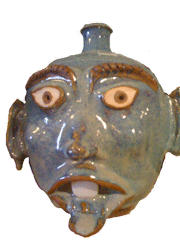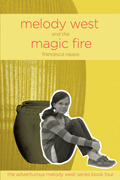Comments are closed.
Magic Fire
Annie and James and I just returned home from spending the weekend at the potter Sabra Ellerby’s farm in Snow Ridge.  We had an awesome time! Sabra is teaching Annie’s brother Billy how to turn pottery on the wheel, and sometimes Annie and James and I go with him to learn how to make pottery too. Our latest project was Face jugs. Mugs, really. My friend Deirdre Maples told me Face jugs were made by American potters in the 1800s and were made to look like ugly human faces. Potters still make Face jugs today. I made my Face mug by wrapping coils of clay one on top of another and then flattening the coils into smooth walls. I gave my Face mug a big nose, and I used jagged pieces of white pottery for teeth. James put two pieces of glass beneath the nostrils on his Face mug to see what would happen when it melted in the hot fire of the kiln. What a goof! When James’ Face mug came out of the kiln on Sunday morning, it looked like snot was running from its nose!
We had an awesome time! Sabra is teaching Annie’s brother Billy how to turn pottery on the wheel, and sometimes Annie and James and I go with him to learn how to make pottery too. Our latest project was Face jugs. Mugs, really. My friend Deirdre Maples told me Face jugs were made by American potters in the 1800s and were made to look like ugly human faces. Potters still make Face jugs today. I made my Face mug by wrapping coils of clay one on top of another and then flattening the coils into smooth walls. I gave my Face mug a big nose, and I used jagged pieces of white pottery for teeth. James put two pieces of glass beneath the nostrils on his Face mug to see what would happen when it melted in the hot fire of the kiln. What a goof! When James’ Face mug came out of the kiln on Sunday morning, it looked like snot was running from its nose!
What did Annie and James and I do at Sabra’s during the weekend? We watched Sabra and Billy and Sabra’s neighbors burn all the pottery, including our very own Face mugs, in Sabra’s salt-glaze groundhog kiln. By the way, to burn pottery means to fire it at very high temperatures. A kiln is just a big oven. A groundhog kiln is a type of kiln that has been used in the South for years and years. It is made out of bricks and is low and rectangular and is usually buried in the ground or against a hillside. That’s how it got its name. It looks just like a groundhog burrowing into the earth. Pretty cute, huh? What is a salt-glaze groundhog kiln? Using salt is one way to glaze a pot. When the kiln reaches a high temperature, salt is funneled through openings on top of the kiln’s arch, and the salt forms a hard glaze on the pots below. The fire in the kiln was so intense, flames shot right out of the kiln’s chimney! When I watched the fire coming out around the bricks of the kiln openings, I realized something was happening to the pots inside that I didn’t understand. My own Face mug was being transformed. Just how it was being transformed I didn’t exactly know.
What with all the excitement of Sabra burning her groundhog kiln, you would think Annie and James and I didn’t have the time to do anything else. But let me tell you, our weekend was a far cry from being all about pottery. In fact, with the help of our new friend, Sabra’s nephew Matt Ellerby, Annie and James and I did a little detective work and ended up solving a crime. Let me fill you in on the details. One week ago we had a terrible winter storm and there was a black out. While the power was out, someone broke into Mr. Finfrock’s antiques shop downtown and stole a clay pot made by the slave potter Dave. Dave’s pots are in museums and people collect his work, so they are worth a lot of money.
Who is Dave the Potter? Dave lived most of his life during the 1800s before the Civil War in the Edgefield District of South Carolina, which is midway between the Blue Ridge Mountains and the Atlantic Ocean. Dave made some of the largest clay pots ever made in America. His perfectly formed pots have a brownish-green ash glaze and olive green drips. Ash glaze is a liquid glaze some potters dip their pots in before they fire them. Dave’s pots were made for storing meat and lard and cornmeal and for preserving pickles. Today we have plastic containers and refrigerators to store and preserve food. But potters like Dave who lived in South Carolina in the 1800s made pottery to preserve and store food on the plantation. Here in North Carolina, pottery was made in the 1800s to preserve and store food on the farm. But no matter where pottery was made, it was backbreaking work. Clay had to be dug out of clay beds. Trees had to be cut down in the forests for fuel. Kilns had to be built out of bricks. Pots had to be made by turning the clay on a wheel. Pots had to be burned in kilns with the wood that had been harvested. And potters had to do this by the sweat of their brow, with their own two hands.
The neat thing is Dave wrote clever poetry on some of his pots. This is one of my favorites:
I WONDER WHERE IS ALL MY RELATIONS
FRIENDSHIP TO ALL AND EVERY NATION
“But what about the theft?” you ask. Well, Mr. Finfrock nearly had a fit when he saw Dave’s pot was missing and a note was in its place. The riddle on the note read: “An apple a day, keeps the antiques dealer away.” Odd, huh? Mr. Finfrock had no choice but to call the police. The detective who arrived on the scene insisted the seller was the most likely culprit. So I set out with Annie and James and Matt to answer the riddle and solve the crime. Let’s just say we ended up creeping around a graveyard and snooping around one of the scariest places on earth before we stumbled onto some clues. But it wasn’t until we put on a magic show for Matt’s friends and neighbors and performed the Metamorphosis, an illusion made famous by the escape artist Harry Houdini, that we were able to solve the crime once and for all.
What did I learn during all this excitement? Besides learning that fractions in math can come in quite handy (especially when your friend is trying to trick you with a shell game and three cups and a ball), I learned that everything in life is a mystery to be solved. For example, I learned the shape of a pot and the glaze on a pot are two important clues in figuring out where a pot was made and who made it. Shapes and glazes are just like fingerprints, because every potter has a unique way of turning a pot and a preference for certain types of glazes. I realized this when I saw the two antique pots in Mr. Finfrock’s shop. The pots had very different shapes and glazes.
The first pot was made by the potter Daniel Seagle, who lived in the 1800s in the Catawba Valley in North Carolina, where the Piedmont begins to rise toward the Appalachian Mountains. This pot was large and round and had thin walls and carefully pulled handles. It had a deep green color and drips down its sides from an ash glaze. Like other potters in the Catawba Valley, Seagle dipped his pots in an ash glaze before he fired them in his kiln. The other pot was made by Chester Webster, who lived in the North Carolina Piedmont in the 1800s. Like other potters in the Piedmont, Webster used salt to glaze his pots. Webster’s pot had a ruddy-brown color and dark honey-colored drips across its handles and shoulders. The dark honey-colored drips were made when the wood ash flew through the kiln during the firing and salting and melted across the surface of the pot like honey off a spoon. The pot also had a lovely image of a bird on its surface. Chester Webster is known for carving bird and fish designs onto the surface of his pots, so Mr. Finfrock was able to tell who made it right away.
By far, my favorite piece of pottery was made by the contemporary North Carolina potter Pam Owens. For breakfast one morning Sabra served tea in Pam’s teapot and mugs. The teapot was really beautiful! Its glaze reminded me of a lacy shawl. Sabra remarked that Pam’s teapot looked just like a lady dressed up for a night out on the town. Perhaps you’re wondering how potters like Sabra and Pam turn pots on the wheel and burn pots in a kiln. Well, I’ve seen it first hand, and I still don’t know how they do it. The wet clay seems to rise up effortlessly and magically over the spinning wheel, and the fire is so bright you can’t even look inside the kiln! I guess making pottery is just like the magic illusions Matt performed on the stage. Instead of using boxes and hats and silk scarves and metal rings to transform one object into another, potters use the basic elements of earth and water and fire and air and in doing so, they magically turn mud into gold!
~mTw~
Filed under | Comments Off on Magic Fire



